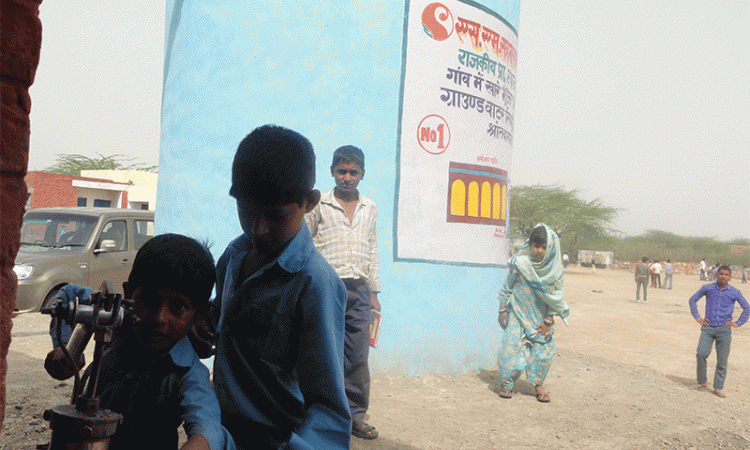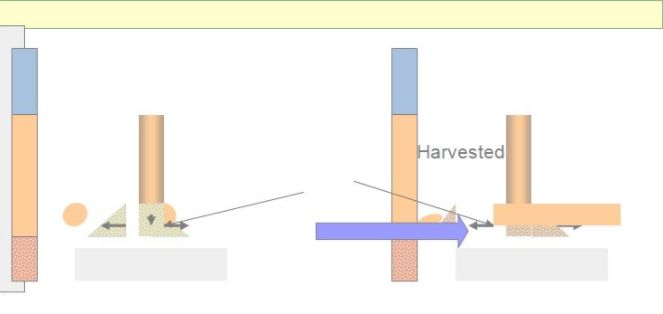
One of the major causes of deterioration of water quality is the increase in overall salinity. Total hardness and the presence of materials like fluoride, nitrate, iron, arsenic, and toxic metal ions determine salinity levels in groundwater. With the demand for groundwater growing rapidly, its exploitation is also accelerating which causes depletion. Depletion of groundwater changes the flow (both direction and velocity) of the groundwater which may cause the inflow of polluted water into the freshwater aquifer from surrounding areas. In coastal areas, this results in seawater intrusion into the freshwater aquifer. Major consequences of this include a rise in the levels and spread of groundwater salinity and the consequent potable water scarcity.
Rainwater forms a crucial source of freshwater, particularly in areas with saline groundwater. Here, rainwater is the only local source of potable water but its availability is limited. Thus, while assessing the available technologies to create a localised source of potable water in these conditions, roof water harvesting was prioritised over others. Conventionally, harvested rainwater is either stored in tanks or recharged into the aquifer. In case of storing rainwater for direct use, the capacity of storage tanks can be a limitation. The high capital cost of constructing larger capacity storage tanks becomes a bottleneck, pressing the need to find an alternative.
Another conventional option available is to recharge the groundwater with harvested rainwater. Usually, in this case, recharging is done at a depth under the ground, leaving safe distance above the groundwater table to avoid chances of contamination of groundwater. The recharged water percolates into the ground and being of lighter density, it starts collecting over the existing denser saline groundwater. But this recharged fresh water does not remain in a consolidated mass and spreads out over time. Eventually, in order to maintain hydraulic equilibrium, the recharged freshwater forms a thin layer over the existing saline groundwater as shown in the figure here.

Exploiting this thin layer of fresh groundwater separately is practically difficult as it mixes with the existing saline groundwater in the process. In order to exploit the harvested rainwater separately, it should form a sizeable pool or pocket instead of a thin layer spread over a larger area. Given the limitations of the existing roof water harvesting (RWH) models, a viable RWH model for exploiting the harvested rainwater was needed.
An innovative model to address these issues
To address the issue of potable water scarcity caused by salinity, an innovative RWH model was conceived and tested in the salinity affected Mewat district, Haryana. The need to innovate was felt because of the non-suitability of available technologies in the region and due to local conditions/constraints like:
- high dependence on groundwater
- short rainy season with low annual average rainfall of 594 mm, 31 rainy days
- shallow groundwater table
- high levels of groundwater salinity
- non-availability of reliable grid electrical supply
- inability to afford alternatives like reverse osmosis
- difficulty in operation and maintenance of high-end technology
In the project, the constraints of the saline aquifer have been turned into an opportunity through an innovative technological solution. Saline groundwater areas witness widening incidences of salinity in aquifers due to unhampered recharge of shallow aquifers and no extraction. These apparent constraints also call for effective management of water resources in surrounding areas to decrease the risk of widening incidence of salinity. RWH has been widely acknowledged as an effective solution to address water scarcity. Nevertheless, the need was felt to innovate the conventional RWH model into a more apt model for saline groundwater areas. Unlike surface water sources or storage of harvested rainwater, the rainwater is stored in the aquifer under the ground and is not subjected to loss due to evaporation or lack of storage tank capacity. This means the harvested water can also provide an essential basis of water security (potable uses) during low rainfall years.
In the new model, recharge wells are sunk to a depth, lower than groundwater table. With it forms the desired freshwater pocket by pushing away and replacing the existing saline groundwater. The harvested freshwater remains a consolidated mass due to pressure exerted by the surrounding saline groundwater. The harvested water from this pocket can be extracted through a pump without it mixing with the surrounding saline groundwater.
Most often, in saline groundwater areas groundwater tables are found to be shallow. The shallow depth is another challenge as it limits the rate of recharging due to low hydrostatic pressure (overburden pressure) and the quantity of recharge. To overcome this challenge, the recharge well in this model has been raised to roof height, leaving a margin to accommodate a pre-filter that removes suspended and floating materials coming with rainwater from the roof. This way, the hydrostatic pressure for recharging is increased with an additional hydrostatic head.

The new model gets tested in villages
In villages, the socio-economic status of households is closely linked with the availability of water. In villages with saline groundwater, purchasing potable water exerts an additional financial pressure on poor households. Water scarcity has been known to have an adverse impact on women and children. In rural areas across the country, women are allocated water-related labour activities. In schools, without potable water, it’s not possible to cook midday meals, and many children leave school early in the day to go home to drink water. Most do not return for the rest of the day. Girls miss school altogether because they have to spend hours each day fetching water for their families.
In order to overcome these barriers in imparting education in schools, the model was pilot tested in a government school in Untka village of Mewat. Apart from this, demonstrations have been conducted at three more government schools of Nagina and Nuh block in Mewat. The construction of all the four structures has been completed and the systems are functional for over two years now. The target beneficiaries of the project are students, teachers and other staff of government schools in these locations.
At the government school building in Untka village, the groundwater is highly saline with total dissolved solids (TDS) at 5980 mg/l. The school caters to 297 students and did not have a local source of water. Its daily requirement of water for drinking and midday meal cooking was estimated at 750 litres (297@2.5 litres/day) and total annual water demand is 1,50,000 litres, for 200 working days per year.
In 2013, the roof water harvesting system was established to recharge aquifer with rainwater using the described innovative model. With the financial support from the Department of Science and Technology (Government of India), the RWH unit was set up for a roof area of 638 square metres to capture rainwater. The average annual rainfall of 594 mm can result in an estimated annual harvest of 322,126 litres of water, considering the run-off factor as 0.85.
Since July 2013, the school has been using the recharged water that is made safe for drinking by filtration through a biosand filter. This filtration process eliminates the risk of biological contamination. The salinity level of water pumped from the pool of freshwater is below 100 mg/l (permissible level of TDS) and is made available around the year. The present water harvesting capacity surpasses the required amount, resulting in sustainable and reliable water supply for the school. The picture above shows the model and an actual picture of the site.
The model omits the need for constructing expensive storage structures used in conventional RWH models. The cost involved in construction, operation and maintenance of this model is far less than alternative methods of water treatment like reverse osmosis system. By making available a source of potable water locally, the innovation reduces the demand for transported fresh water from the already overstressed sources lying outside of this saline area. It also saves the distribution losses, energy, and transportation cost and their footprint on the environment.
The experience from Untka school and other demonstrations suggest that replication of the model is highly affordable. The model has high scaling potential in regions with saline groundwater including semi-arid areas and coastal areas where seawater ingress poses a major challenge of groundwater salinity. Though this model has been conceptualised and developed in shallow aquifer areas, it can also be adapted for deeper saline aquifers and seawater intrusion affected areas.
The model has been demonstrated in a few salinity-affected areas. Now the plan is to showcase these demonstrations for technology transfer and building capacities of stakeholders around this innovative technology to create sources of potable water locally in salinity-affected groundwater areas.
“Earlier we were dependent on irregular and unclean tanker supply for drinking water. We used to go back home to drink water and not come back.”
~Mohammad Musaraf, Untka school, Mewat
“We learned about a new scientific concept and water conservation model that works on our school premises.”
~Vajika Nazia, Malab school, Mewat
References
Sharma, L. (2014). Innovation for Making Potable Water Available in Saline Groundwater Areas. Journal of Water Resource and Protection. Retrieved from http://file.scirp.org/Html/4-9402305_50615.htm
Sharma, L. M., & Sood, S. (2015). Challenges of dryland areas and community-based technological solutions for drought proofing. IOSR Journal of Environmental Science Ver. II, 9(4), 2319–2399. doi:10.9790/2402-09425360
Sharma, L., Satyavada, A., & Chowdhury, A. (2012). Water Quality and Human Health in Mewat: Challenges and Innovative Solutions. In Interlacing Water and Human Health Case Studies from South Asia(pp200-229) . SAGE Publications.
Disclaimer: The views and opinions expressed in this article are those of the author/s and do not necessarily reflect the policy or position of India Water Portal.